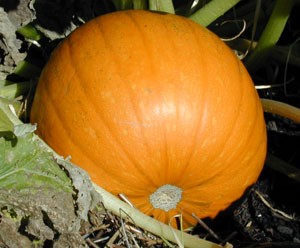In autumn, the ripe pumpkins are harvested when the skin is no longer green, the fruit sounds hollow when tapped and the stem base is hard and woody. You can then store them at home for several more weeks or eat them right away.
Contents
Mineral deficiency in the soil
One reason is a calcium deficiency in the soil (similar to stippling in apples). You can compensate this by giving calcium fertilizer during the growth phase.

Pumpkins can develop rotten spots for a variety of reasons, and these spots are typically signs of decay or disease. Here are some common factors that can cause pumpkins to develop rotten spots:
- Fungal Diseases: Fungal diseases like powdery mildew, downy mildew, and gray mold can affect pumpkin plants. These fungi can cause various types of spots and rot on the leaves, stems, and fruit. The spots may initially appear as small, discolored areas and then develop into more significant rot.
- Bacterial Infections: Bacterial diseases, such as bacterial soft rot and bacterial leaf spot, can also affect pumpkins. Bacterial soft rot can lead to mushy, water-soaked areas on the pumpkin’s surface. Bacterial leaf spot can cause small, dark spots on the leaves and fruit, which may eventually lead to rot.
- Physical Damage: Physical damage to the pumpkin’s skin, such as cuts, bruises, or punctures, can create entry points for pathogens, including fungi and bacteria. These damaged areas are more susceptible to rot.
- Improper Storage: If pumpkins are not stored in the right conditions, they can develop rot. They should be kept in a cool, dry, and well-ventilated area. High humidity or exposure to moisture can lead to mold and rot.
- Insects and Pests: Insects and pests can damage pumpkins, creating wounds that can become infected by pathogens, leading to rot.
- Overripe Pumpkins: As pumpkins ripen and age, they become more susceptible to rot. Overripe pumpkins are often more fragile and can develop soft spots and rot more easily.
- Environmental Conditions: Wet and humid weather can promote the growth of molds and fungi, increasing the likelihood of pumpkin rot. Proper spacing and ventilation in the pumpkin patch can help reduce humidity around the plants.
To prevent and manage rotten spots on your pumpkins, consider the following measures:
- Plant disease-resistant pumpkin varieties: Some pumpkin varieties are more resistant to certain diseases, so choose your varieties carefully.
- Proper watering: Water the plants at the base, avoiding wetting the leaves. This can help reduce the risk of fungal diseases.
- Monitor for pests: Regularly inspect your pumpkins for signs of pest damage and take appropriate action if pests are present.
- Harvest at the right time: Harvest pumpkins when they are fully mature but not overripe. Store them in a cool, dry place with good ventilation.
- Practice crop rotation: If you grow pumpkins in the same location each year, consider rotating your crops to reduce the risk of soil-borne diseases.
- Fungicides and bactericides: In severe cases of fungal or bacterial infections, you may need to use appropriate treatments to control the disease.
Proper care and maintenance can go a long way in preventing rotten spots on your pumpkins and ensuring a healthy harvest.
You can always dissolves calcium effervescent tablets (pharmacy) and administers this mixture by watering can. You can also grind eggshells and mix them into the soil. It is best to water with water from the tap, not with soft rainwater. Rainwater has almost no lime.
A second possibility is that a fungus in the soil is damaging the plants/fruits. If the leaves remain healthy, it should be a fungus that specifically attacks fruit (like Monillia). This is where an antifungal would help, but…you still want to eat the squash! We do not recommend eating after spraying. Even though pumpkins have thick skins, there are still better ways to prevent or avoid a fungal infection.
Five tips against fungi
- Keep pumpkins dry from underneath. Spread straw on the ground or mulch material to keep the fruit from lying on wet soil. Replace the soil for the coming season and provide pathogen-free substrate for the next set of pumpkins
- The climbing varieties can grow up supports. Towards the end of the season, clip the shoot ends from all pumpkin plants. During the fruiting period, additional potash-rich fertilizer or appropriate liquid fertilizer is given every two weeks
- You need to make sure that the plant (leaves and fruits) does not get too wet. So water in the morning at the roots and not with the sprinkler. Fungal diseases develop with preference in a cool, damp environment.
- For a boost, feel free to try a plant liquid manure. These concentrated plant broths are mixed with water and applied weekly. This way you save on fertilizer and garden organically.
- You can also remove some of the lower leaves so that the fruits get enough light. This way the fruits ripen better and dry faster when it rains.









